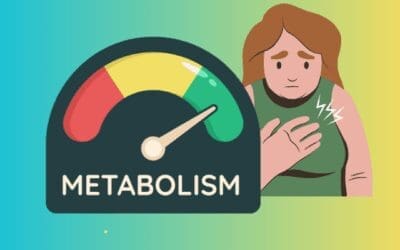Before we dive into strategies, it’s important to understand that targeting fat loss in a specific area (like your belly) isn’t quite how our bodies work. While some exercises can strengthen muscles in specific areas, overall weight loss requires a broader approach. The good news? By incorporating these 20 science-backed tips, you can achieve sustainable weight loss and improve your overall health in your forties!
Understanding Fat Loss
Our bodies store excess energy as fat. When we consume fewer calories than we burn, our bodies tap into these fat stores for fuel. This process involves two key steps:
- Lipolysis: Fat cells break down stored triglycerides (fats) into free fatty acids.
- Beta-oxidation: These free fatty acids are transported to the liver and muscles, where they are burned for energy.
Many of us dream of targeting specific areas for fat loss, like the stubborn belly fat. Unfortunately, spot reduction, the idea of losing fat only in a specific area through exercise, is a common misconception. Here’s why:
- Our bodies mobilize fat stores differently: Unlike a targeted fat-burning machine, our bodies release stored fat systemically in response to an overall calorie deficit. This means exercising a specific muscle group, like doing crunches for your belly, won’t necessarily lead to direct fat loss in that area.
- Genetics play a role: Our individual genetic makeup influences where our bodies tend to store and release fat. This is why some people naturally carry more weight in their legs, arms, or belly.
So, what’s the correct approach to losing fat?
Instead of chasing the spot reduction myth, we need to focus on overall healthy habits that promote sustainable weight loss and improve well-being.
So let us take a look at 20 habits you can practice to get rid of that belly fat and start living life in your forties!
20 Strategies for a Healthier You
1. Fiber Up!
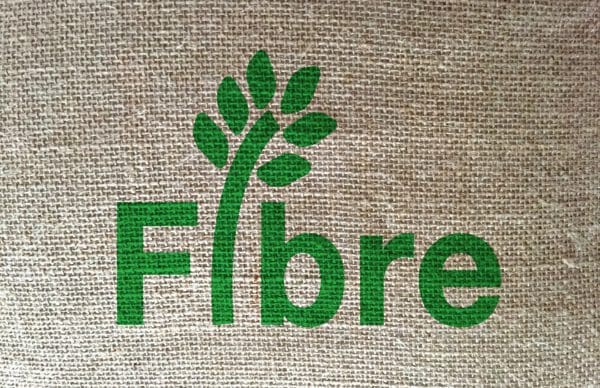
Fill your plate with soluble fiber, a type of fiber found in various delicious and nutritious foods. Here’s why it’s your weight management ally:
- Feeling Fuller for Longer: Soluble fiber absorbs water in your digestive system, forming a gel-like substance that slows down digestion. This keeps you feeling satisfied for longer, potentially reducing cravings and helping you manage your calorie intake.
- Blood Sugar Regulation: Soluble fiber helps regulate blood sugar by slowing down the absorption of sugar into the bloodstream. This prevents spikes and dips in blood sugar levels, which can contribute to increased hunger and cravings.
- Gut Health Champion: Soluble fiber acts as a prebiotic, feeding the good bacteria in your gut. A healthy gut microbiome has been linked to various health benefits, including improved digestion, weight management, and even a stronger immune system.
Where to find soluble fiber:
- Fruits: Berries (strawberries, raspberries, blueberries), apples, pears, citrus fruits (oranges, grapefruits)
- Vegetables: Brussels sprouts, broccoli, carrots, sweet potatoes, okra
- Legumes: Lentils, beans (black beans, kidney beans), peas
- Grains: Oats, barley, chia seeds, flaxseeds (ground)
Tips for incorporating more soluble fiber:
- Start your day with a fiber-rich breakfast: Add berries to your oatmeal, enjoy a side of fruit with your eggs, or whip up a smoothie with spinach and banana.
- Snack smart: Opt for fruits, vegetables with hummus, or a handful of nuts and seeds.
- Bulk up your meals: Add chopped vegetables to soups, stews, and stir-fries.
- Choose whole grains: Swap white bread and pasta for whole-wheat options.
2. Start Eating More Protein
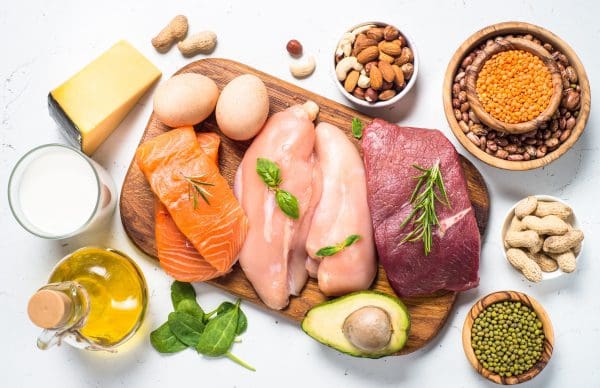
Include protein-rich foods like fish, chicken, eggs, and beans in your diet. Protein helps build muscle and keeps you feeling satisfied.
Why is protein important?
- Muscle Building and Repair: Protein plays a crucial role in building and maintaining muscle mass. As we age, muscle mass naturally declines, which can contribute to a slower metabolism. Including protein in your diet helps counteract this decline, supporting a healthy metabolism and promoting strength.
- Feeling Fuller for Longer: Protein is known for its satiating properties, helping you feel fuller for longer and potentially reducing cravings and helping you manage calorie intake. This can be particularly beneficial for weight management.
- Increased Metabolism: Your body burns more calories when digesting and utilizing protein compared to fat or carbohydrates. This thermogenic effect can contribute to a slight boost in your metabolism, aiding weight management efforts.
Tips for incorporating protein:
- Start your day with protein: Include eggs, Greek yogurt, or a protein smoothie in your breakfast routine to kickstart your metabolism and feel satisfied throughout the morning.
- Pair protein with every meal: Add grilled chicken or fish to salads, incorporate beans into soups and stews, or enjoy a handful of nuts as a healthy snack.
- Explore plant-based options: If you follow a vegetarian or vegan diet, lentils, beans, tofu, and tempeh are excellent sources of plant-based protein.
3. Stress Less, Slim Down

Chronic stress can contribute to weight gain. Explore relaxation techniques like meditation or yoga to manage stress levels.
The Stress-Weight Gain Connection:
- Cortisol Chaos: When you’re stressed, your body releases the hormone cortisol. While cortisol plays a vital role in the body’s stress response, chronically elevated levels can lead to increased fat storage, particularly around the abdomen.
- Craving Cravings: Stress can trigger cravings for unhealthy, high-calorie foods like sugary snacks and processed treats. This can lead to overeating and hinder your weight management efforts.
- Sleepless Nights: Stress can disrupt sleep patterns, making it difficult to get the recommended 7-8 hours of quality sleep each night. Sleep deprivation can further increase cortisol levels, creating a vicious cycle that can contribute to weight gain.
Combating Stress for a Slimmer You:
- Explore Relaxation Techniques: Techniques like meditation, yoga, and deep breathing exercises can help manage stress effectively. These practices promote relaxation, reduce cortisol levels, and can contribute to improved sleep quality, all of which benefit your weight management efforts.
- Find Your Calming Activity: Whether it’s spending time in nature, listening to calming music, or reading a book, find activities that help you de-stress and unwind. Engaging in these activities regularly can significantly impact your stress levels and overall well-being.
- Prioritize Self-Care: Make time for activities that nourish your mind and body. This could include spending time with loved ones, taking a warm bath, or pursuing a hobby you enjoy. Prioritizing self-care helps manage stress and promotes emotional well-being, which can indirectly support your weight management journey.
4. Cut Down on the Sugar

We all know sugary treats can be tempting, but their impact on your weight management journey goes beyond just empty calories. Here’s why it’s crucial to limit sugary drinks and processed snacks:
The Devious Duo: Blood Sugar Spikes and Crashes:
- Blood Sugar Rollercoaster: Added sugars found in sugary drinks, processed snacks, and even seemingly healthy options like fruit juices, are quickly absorbed into your bloodstream, causing a rapid rise in blood sugar levels.
- The Crash Landing: This sugar surge triggers the release of insulin, a hormone that helps your body utilize the sugar for energy. However, with the sudden influx of sugar, the insulin response can be excessive, leading to a blood sugar crash.
- Craving Chaos: This drop in blood sugar levels leaves you feeling tired, sluggish, and prone to cravings for more sugary treats, perpetuating the cycle and potentially leading to overeating.
Beyond Weight Gain: The Ripple Effect of Sugar Consumption:
- Increased Hunger: High sugar intake can disrupt hormones involved in regulating hunger and satiety, making you feel hungrier more often and potentially leading to overeating.
- Inflammation: Excessive sugar consumption can contribute to low-grade inflammation in the body, which has been linked to various health concerns, including weight gain and chronic diseases.
- Energy Slumps: The constant blood sugar fluctuations caused by sugary foods can lead to energy dips and fatigue, making it harder to maintain an active lifestyle, which can hinder weight management efforts.
Kicking the Sweet Habit:
- Read Food Labels: Be mindful of hidden sugars in seemingly healthy foods like yogurt, salad dressings, and sauces. Pay attention to the “added sugar” content on food labels and choose options lower in added sugars.
- Swap Sugary Drinks for Water: Ditch sugary drinks like soda, juice, and sports drinks for refreshing water, unsweetened tea, or black coffee. These beverages quench your thirst without added sugar and calories.
- Opt for Whole Fruits: Satisfy your sweet tooth with whole fruits like berries, apples, or pears. While they contain natural sugars, they also come packed with fiber, vitamins, and minerals, making them a healthier choice.
- Prepare Homemade Snacks: Instead of processed snacks, prepare homemade alternatives using fresh fruits, vegetables, nuts, and seeds. This allows you to control the ingredients and limit added sugar intake.
By being mindful of sugar consumption and making simple swaps, you can effectively curb the “sugar blues” and create a healthier, more sustainable approach to weight management. Remember, even small changes can make a significant difference in the long run.
5. Get Your Cardio On

Incorporating regular aerobic exercise, often referred to as cardio, is a cornerstone of any successful weight management strategy. Here’s why:
The Calorie-Burning Engine:
- Burning Calories for Energy: During cardio activities like brisk walking, swimming, or dancing, your body utilizes more calories for energy compared to resting. This creates a calorie deficit, which is essential for weight loss as it forces your body to tap into stored fat reserves for fuel.
- Increased Metabolic Rate: Engaging in regular cardio can boost your metabolic rate, even at rest. This means your body burns more calories throughout the day, even when you’re not actively exercising, further aiding in weight management.
Beyond Weight Loss: The All-Encompassing Benefits of Cardio:
- Improved Cardiovascular Health: Regular cardio strengthens your heart muscle, improving its efficiency and pumping power. This translates to better blood circulation, lower blood pressure, and a reduced risk of heart disease, the leading cause of death globally.
- Enhanced Lung Function: Cardio exercises like swimming and cycling strengthen your respiratory system, allowing your lungs to take in and utilize oxygen more efficiently. This translates to improved endurance and stamina, making everyday activities feel easier.
- Mood and Stress Management: Physical activity releases endorphins, hormones known for their mood-boosting and stress-reducing effects. Engaging in regular cardio can help combat stress, improve sleep quality, and contribute to overall well-being.
Finding Your Cardio Groove:
- Choose Activities You Enjoy: The key to consistency is finding activities you genuinely enjoy. Whether it’s brisk walking in nature, swimming laps at the pool, or dancing to your favorite music, choose activities that bring you joy and make exercise feel less like a chore.
- Start Slowly and Gradually Increase: If you’re new to exercise, begin with shorter durations and gradually increase the intensity and duration of your workouts as your fitness level improves.
- Aim for at Least 150 Minutes Per Week: The Centers for Disease Control and Prevention (CDC) recommends at least 150 minutes of moderate-intensity aerobic activity or 75 minutes of vigorous-intensity aerobic activity per week for adults.
By incorporating regular cardio into your routine, you can unlock its powerful benefits for weight loss, overall fitness, and well-being. Remember, consistency is key, so find activities you enjoy and gradually build on your exercise routine to achieve sustainable progress.
6. Daily Dose of Movement

Making walking a daily habit is a simple yet powerful strategy for incorporating more movement into your routine and supporting your weight management journey. Here’s why:
A Step Towards a Healthier You:
- Low-Impact Exercise: Walking is a gentle, low-impact exercise suitable for most fitness levels. It’s easy on your joints, making it a great option for beginners or those returning to exercise after a break.
- Burn Calories: While not as high-intensity as some exercises, walking still helps you burn calories, contributing to your overall calorie deficit and aiding in weight management.
- Boosts Mood and Energy Levels: Physical activity releases endorphins, hormones that elevate mood and combat feelings of fatigue. Regular walks can leave you feeling more energized, positive, and motivated throughout the day.
Beyond Weight Management: The Alluring Benefits of Walking:
- Improved Cardiovascular Health: Walking strengthens your heart muscle and improves blood circulation, lowering your risk of heart disease.
- Stronger Bones and Muscles: While not as effective as strength training, regular walking helps maintain bone density and muscle mass, reducing the risk of falls and injuries, and improving overall functional mobility.
- Stress Management: Walking provides a valuable opportunity to disconnect from daily pressures and clear your mind. Immersing yourself in nature during walks can further enhance your stress-relieving benefits.
Making Walking a Habit:
- Start Small: Begin with short walks, like 10-15 minutes, and gradually increase the duration as your fitness improves.
- Incorporate it into Your Routine: Take the stairs instead of the elevator, park further away from your destination, or take a walking break during your workday.
- Find a Walking Buddy: Enlist a friend or family member to join you on your walks, making them more social and enjoyable.
- Explore Different Routes: Choose scenic routes in parks, neighborhoods, or nature trails to keep your walks engaging and motivating.
By incorporating daily walks into your routine, you can reap numerous benefits for your physical and mental well-being while supporting your weight management goals.
7. Be Conscious of Carbs

Carbohydrates are an essential part of a balanced diet, but not all carbs are created equal. Here’s why focusing on complex carbohydrates over refined carbohydrates can benefit your weight management efforts and overall health:
Understanding Carbs:
- Fuel for the Body: Carbohydrates are the primary source of energy for your body. They are broken down into glucose, a type of sugar, which your cells use for various functions.
- Two Main Types: There are two main types of carbohydrates: complex carbohydrates and refined carbohydrates.
The Power of Complex Carbs:
- Fiber Powerhouse: Complex carbohydrates, found in whole grains (brown rice, quinoa, whole-wheat bread), legumes (beans, lentils), and starchy vegetables (sweet potatoes, corn), are packed with fiber. Fiber slows down the digestion and absorption of sugar into the bloodstream. This helps with:
- Blood Sugar Control: By preventing blood sugar spikes and crashes, complex carbs promote stable energy levels and reduce cravings throughout the day.
- Feeling Fuller for Longer: Fiber keeps you feeling satisfied for longer, potentially helping you manage calorie intake and avoid overeating.
- Sustained Energy: Complex carbs provide a steady release of energy, keeping you fueled for your workouts and daily activities.
The Downside of Refined Carbs:
- Rapidly Digested: Refined carbohydrates, found in white bread, pasta, sugary cereals, and processed snacks, are stripped of their fiber and nutrients during processing. This leads to rapid digestion and absorption of sugar into the bloodstream.
- Blood Sugar Rollercoaster: The quick sugar surge caused by refined carbs can lead to blood sugar spikes and crashes, leaving you feeling tired, sluggish, and prone to cravings for more sugar.
- Empty Calories: Refined carbs often provide little to no essential nutrients, making them “empty calories” that contribute to weight gain without providing lasting benefits.
Making Smart Choices:
- Read Food Labels: Pay attention to the fiber content on food labels. Aim for foods with higher fiber content, indicating they are likely complex carbohydrates.
- Swap Refined Grains for Whole Grains: Choose brown rice over white rice, opt for whole-wheat bread instead of white bread, and explore nutritious options like quinoa and barley.
- Pair Carbs with Protein and Healthy Fats: Combine complex carbs with a source of protein (lean meat, fish) and healthy fats (avocado, nuts) to create a balanced meal that promotes satiety and blood sugar control.
By making smart carb choices and prioritizing complex carbohydrates over refined options, you can ensure your body receives the sustained energy it needs while promoting weight management and overall health.
8. Start Strength Training

Strength training, often involving weightlifting or bodyweight exercises, plays a crucial role in building and maintaining muscle mass. Here’s why incorporating it into your routine can significantly benefit your weight management journey and overall health:
Muscle: The Metabolic Engine:
- Metabolic Boost: Muscle tissue is metabolically active, meaning it burns calories even at rest. This increased metabolic rate contributes to burning more calories throughout the day, even when you’re not actively exercising, aiding in weight management. Studies suggest that each pound of muscle burns around 6 calories per day, compared to 2-3 calories for a pound of fat.
- Fat Burning Machine: Strength training not only builds muscle but also helps preserve and even increase muscle mass as we age. This is crucial, as muscle mass naturally declines with age, leading to a slower metabolism and potential weight gain. By building and maintaining muscle, you can counteract this decline and keep your metabolism burning efficiently.
Beyond Weight Management: The Alluring Benefits of Strength Training:
- Improved Strength and Power: Strength training increases your muscular strength and power, making everyday activities like carrying groceries or climbing stairs feel easier and reducing your risk of injuries.
- Stronger Bones: Regular strength training helps maintain bone density, reducing the risk of osteoporosis and fractures, especially important as we age.
- Improved Body Composition: Building muscle definition can help improve your overall body composition, shaping and toning your physique.
- Enhanced Confidence: Strength training can boost your confidence and self-esteem by helping you feel stronger and more capable in your body.
Getting Started with Strength Training:
- Seek Guidance: If you’re new to strength training, consulting with a certified personal trainer can help you learn proper form and technique to prevent injuries and ensure you’re targeting the desired muscle groups effectively.
- Start Light and Gradually Increase: Begin with lighter weights or bodyweight exercises and gradually increase the weight or intensity as your strength improves.
- Focus on Form: Proper form is crucial to maximize the benefits and minimize the risk of injury. Focus on controlled movements and ensure you’re targeting the intended muscle group with each exercise.
- Incorporate Regular Sessions: Aim for strength training sessions 2-3 times per week, focusing on major muscle groups like your legs, back, chest, shoulders, and core.
9. Choose Healthy Fats
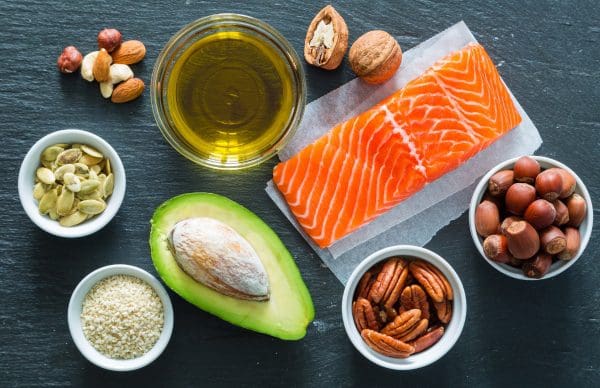
Dietary fat often gets a bad rap, but not all fats are created equal. In fact, incorporating healthy fats from sources like avocados, nuts, seeds, and olive oil into your diet can be a game-changer for weight management, heart health, and overall well-being. Here’s why:
Understanding Healthy Fats:
- Essential Nutrients: Healthy fats provide your body with essential nutrients like vitamin E and healthy fats that your body can’t produce on its own. These nutrients play a vital role in various bodily functions, including hormone production and cell health.
- Feeling Satisfied for Longer: Healthy fats are digested slower than carbohydrates, promoting feelings of satiety and fullness. This can help you manage calorie intake and reduce cravings throughout the day, which can be beneficial for weight management.
The Heart-Healthy Benefits:
- Good Cholesterol Boost: Healthy fats, particularly monounsaturated fats (found in olive oil and avocados) and polyunsaturated fats (found in nuts and seeds), can help increase HDL levels (good cholesterol). HDL cholesterol helps remove LDL cholesterol (bad cholesterol) from your arteries, reducing the risk of heart disease.
- Reduced Inflammation: Healthy fats have anti-inflammatory properties that can help combat chronic inflammation, a risk factor for various health problems, including heart disease.
Making Smart Choices:
- Limit Saturated Fats: While some saturated fat is naturally present in healthy foods like meat and dairy, it’s important to limit saturated fats from sources like processed meats and fried foods.
- Trans Fats Out, Healthy Fats In: Eliminate trans fats from your diet by avoiding processed snacks, fried foods, and commercially baked goods. Instead, focus on incorporating healthy fats from these delicious and nutritious sources:
- Avocados: A creamy and versatile source of healthy fats, fiber, and vitamins.
- Nuts and Seeds: Almonds, walnuts, chia seeds, and flaxseeds are excellent sources of healthy fats, protein, and fiber. Enjoy them in moderation as snacks or add them to yogurt, oatmeal, or salads.
- Olive Oil: Extra virgin olive oil is a heart-healthy fat rich in antioxidants. Use it for salad dressings, cooking, or drizzled on vegetables.
- Fatty Fish: Salmon, tuna, and mackerel are packed with omega-3 fatty acids, a type of polyunsaturated fat with numerous health benefits, including reducing inflammation and improving heart health.
Incorporating Healthy Fats:
- Plan Your Meals: Include healthy fats in each meal and snack. For example, add avocado slices to your morning toast, sprinkle nuts on your salad for lunch, or enjoy a handful of almonds as an afternoon snack.
- Cooking with Healthy Fats: Use healthy oils like olive oil or avocado oil for cooking and sauteing instead of butter or unhealthy fats.
10. Rest for Success

Getting 7-8 hours of quality sleep each night is crucial for overall health and well-being, but it also plays a significant role in your weight management journey. Here’s why prioritizing quality sleep is essential:
The Sleep-Weight Connection:
- Hormonal Havoc: When you’re sleep-deprived, your body produces more ghrelin, the hunger hormone, and less leptin, the satiety hormone. This hormonal imbalance can lead to increased feelings of hunger and cravings, making it harder to manage calorie intake and potentially leading to overeating.
- Metabolic Mayhem: Sleep deprivation disrupts your metabolism, the process by which your body converts food into energy. This can lead to decreased insulin sensitivity, making it harder for your body to utilize blood sugar effectively.
Beyond Weight Management: The Ripple Effect of Sleep Deprivation:
- Reduced Energy Levels: Lack of sleep can leave you feeling tired and sluggish, making it harder to engage in physical activity and maintain an active lifestyle, both crucial for weight management.
- Increased Stress: Sleep deprivation can exacerbate stress levels, which can further worsen hormonal imbalances and contribute to weight gain.
- Weakened Immune System: Chronic sleep deprivation can weaken your immune system, making you more susceptible to illnesses, potentially hindering your weight management efforts and overall health.
Prioritizing Quality Sleep for Success:
- Create a Relaxing Bedtime Routine: Establish a consistent sleep schedule and develop a relaxing bedtime routine that helps you wind down before sleep. This could involve taking a warm bath, reading a book, or practicing relaxation techniques like deep breathing or meditation.
- Optimize Your Sleep Environment: Ensure your bedroom is dark, quiet, cool, and clutter-free to create a sleep-conducive environment.
- Limit Screen Time before Bed: The blue light emitted from electronic devices can disrupt sleep patterns. Avoid using electronic devices for at least an hour before bedtime.
- Seek Professional Help if Needed: If you experience chronic sleep problems like insomnia or sleep apnea, consult a healthcare professional to discuss treatment options.
11. Track Your Journey

Embarking on a weight management journey is a marathon, not a sprint. Tracking your progress can be a powerful tool for staying accountable, identifying areas for improvement, and celebrating your achievements. Here’s how:
The Power of Tracking:
- Increased Accountability: Recording your food intake, exercise routines, and sleep patterns can hold you accountable and keep you motivated to stick to your goals. Seeing your choices and progress documented can serve as a reminder of your commitment and provide a sense of accomplishment.
- Identifying Patterns: Tracking allows you to analyze your habits and identify patterns. You might discover connections between certain foods and energy levels, or notice how sleep quality impacts your cravings. This self-awareness can empower you to make informed adjustments and personalize your approach for optimal results.
- Celebrating Milestones: Tracking your progress allows you to celebrate milestones, no matter how big or small. Witnessing your progress over time can be a significant motivator, boosting your confidence and encouraging you to stay on track.
Choosing Your Tracking Method:
- Food Diary: Keeping a food diary involves recording everything you eat and drink throughout the day. This can be done in a physical notebook or using a digital app. Pay attention to portion sizes, meal timings, and how you feel after consuming certain foods.
- Fitness Tracker: Wearable fitness trackers can monitor various aspects of your health and fitness, including your daily activity levels, sleep patterns, and heart rate. These devices can provide valuable insights into your overall activity and encourage you to reach your daily step goals or increase your exercise intensity.
Remember:
- Focus on Progress, Not Perfection: Tracking is not about achieving perfection, but rather about gaining self-awareness and making progress over time. Don’t be discouraged by setbacks, view them as learning opportunities and adjust your approach accordingly.
- Find a Method that Works for You: Experiment with different tracking methods and choose the one that best suits your preferences and lifestyle. Consistency is key, so find a method you can easily integrate into your routine.
12. Start Eating Fatty Fish

Incorporating fatty fish like salmon, tuna, and mackerel into your diet offers a delicious and nutritious way to boost your omega-3 fatty acid intake. These essential nutrients offer numerous health benefits, and may also support weight management efforts.
The Power of Omega-3s:
- Essential for the Body: Omega-3 fatty acids are essential nutrients your body cannot produce on its own, making it crucial to obtain them through your diet. They play a vital role in various bodily functions, including brain function, eye health, and heart health.
- Anti-inflammatory Properties: Omega-3s possess potent anti-inflammatory properties. Chronic low-grade inflammation has been linked to various health concerns, including obesity and metabolic disorders. Including omega-3s in your diet may help combat this inflammation, potentially contributing to improved overall health.
Potential Benefits for Weight Management:
- Increased Satiety: Some studies suggest that omega-3s may promote feelings of satiety and fullness, potentially reducing cravings and helping you manage calorie intake.
- Improved Insulin Sensitivity: Omega-3s may help improve insulin sensitivity, allowing your body to utilize blood sugar more efficiently. This can be beneficial for weight management and blood sugar control.
- Enhanced Metabolism: Research suggests that omega-3s may slightly boost your metabolism. While the effect is likely modest, it can contribute to burning more calories throughout the day.
Additional Benefits of Fatty Fish:
- Rich in Protein: Fatty fish is an excellent source of high-quality protein, which is essential for building and maintaining muscle mass. Building muscle can further support a healthy metabolism and contribute to weight management.
- Vitamin and Mineral Powerhouse: Fatty fish packs a punch of essential vitamins and minerals, including vitamin D, vitamin B12, and selenium, all crucial for various bodily functions and overall health.
Making Fatty Fish a Part of Your Diet:
- Aim for 2-3 Servings per Week: Include 2-3 servings of fatty fish like salmon, tuna, or mackerel in your weekly meals.
- Variety is Key: Explore different varieties of fatty fish to keep your meals exciting. Try salmon baked with lemon and herbs, tuna salad with whole-wheat bread, or grilled mackerel with roasted vegetables.
- Cooking Methods: Opt for healthy cooking methods like grilling, baking, or poaching to preserve the nutritional value of omega-3 fatty acids.
By incorporating fatty fish into your diet, you can reap the various benefits of omega-3s for overall health. While their direct impact on weight management may be modest, they can contribute to a healthy lifestyle that supports your weight management goals.
13. Probiotics for the Gut
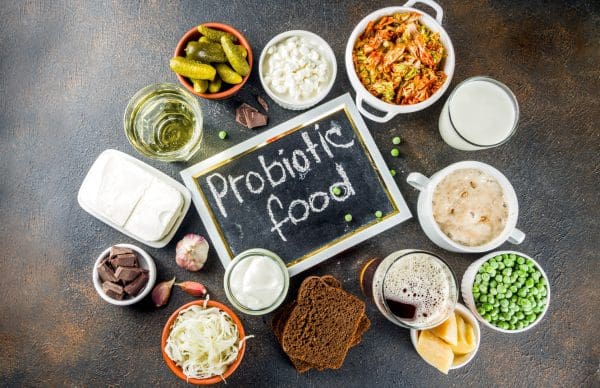
Probiotics, live microorganisms found in fermented foods like yogurt, kefir, kimchi, and some supplements, are gaining increasing attention for their potential health benefits. While research is ongoing, some studies suggest that probiotics may play a role in gut health and potentially contribute to weight management.
Understanding Probiotics:
- Gut Microbiome: Our gut is home to trillions of microorganisms, collectively known as the gut microbiome. This diverse community of bacteria plays a crucial role in digestion, immune function, and overall health.
- Probiotic Power: Probiotics are believed to work by supporting the growth of beneficial bacteria in the gut and crowding out harmful bacteria. This can potentially improve the overall balance and function of the gut microbiome.
The Gut-Weight Management Connection:
- Emerging Research: Studies suggest a potential link between gut health and weight management. Research is exploring how the gut microbiome might influence factors like nutrient absorption, metabolism, and feelings of hunger and satiety.
- Early Findings: Some studies have shown that individuals with a healthy gut microbiome, potentially supported by probiotics, may experience benefits like reduced inflammation, improved insulin sensitivity, and reduced body fat percentage. However, more research is needed to confirm these findings and understand the specific mechanisms involved.
It is important to note that:
- Probiotics are not a magic bullet for weight loss. A balanced diet, regular physical activity, and a healthy lifestyle remain the cornerstones of successful weight management.
- Individual results may vary. The potential benefits of probiotics on weight management can vary depending on individual factors like baseline gut health, diet, and lifestyle.
- Probiotic strains and effectiveness differ. Different probiotic strains offer varying benefits. Choosing a high-quality probiotic supplement with well-researched strains is crucial. Consult a healthcare professional for guidance.
Exploring Probiotics:
- Food Sources: Incorporate fermented foods like yogurt, kefir, kimchi, and kombucha into your diet. Look for products with live and active cultures.
- Supplements: Consider taking a probiotic supplement, but consult a healthcare professional to discuss the potential benefits and risks based on your individual health needs.
Remember:
Probiotics hold promise for supporting gut health and potentially influencing weight management, but further research is needed to fully understand their long-term impact.
14. Green Tea Power

Green tea, a popular beverage enjoyed worldwide, is not only refreshing but also boasts potential health benefits. While not a magic bullet for weight loss, research suggests it may offer a slight boost to metabolism, making it a valuable addition to a healthy lifestyle.
The Power of Antioxidants:
- Packed with Goodness: Green tea is brimming with antioxidants, particularly catechins, which combat harmful free radicals in the body. These antioxidants may offer various health benefits, including improved heart health and potentially aiding in weight management.
A Potential Metabolic Boost:
- Thermogenic Effect: Studies suggest that green tea may possess a thermogenic effect, meaning it can slightly increase your metabolic rate. This translates to burning more calories at rest, which, when combined with a healthy diet and exercise, can contribute to weight management efforts.
- Fat Burning Potential: Some research indicates that green tea may promote fat burning, particularly abdominal fat. However, the evidence is still developing, and more research is needed to confirm these findings.
Important Considerations:
- Modest Effects: The potential metabolic boost and fat-burning effects of green tea are likely modest. They should not be seen as a substitute for a healthy diet and regular physical activity for weight management.
- Individual Variations: The impact of green tea on metabolism and weight management can vary depending on individual factors like genetics, lifestyle, and overall diet.
- Quality Matters: Choose high-quality green tea from reputable sources. Opt for loose leaf or tea bags made from whole leaves for optimal benefits.
Enjoying Green Tea:
- Brew Your Own: Enjoy freshly brewed green tea for the most potent health benefits. Experiment with different steeping times and temperatures to find your preferred taste.
- Incorporate it into Your Routine: Enjoy green tea throughout the day, hot or iced, as a healthy alternative to sugary beverages.
- Combine with a Healthy Lifestyle: Remember, green tea is a potential support system, not a quick fix. Pair it with a balanced diet, regular physical activity, and a healthy lifestyle for optimal results.
By understanding the potential benefits and limitations of green tea, you can incorporate it into your routine as a healthy and refreshing beverage that may offer a slight boost to your weight management journey.
15. Core Strength Matters

While it’s true that crunches alone won’t magically “melt” belly fat, strengthening your core muscles offers a multitude of benefits that go far beyond aesthetics. Here’s why prioritizing core strength is essential for overall health and well-being, regardless of your weight management goals:
Debunking the Myth of Spot Reduction:
- Targeted Fat Loss is a Myth: Unfortunately, our bodies don’t burn fat from specific areas in response to targeted exercises like crunches. Fat loss happens holistically, influenced by a combination of factors like diet, exercise, and genetics.
- Crunches and Belly Fat: While crunches primarily target the rectus abdominis muscle, the “six-pack” muscle, they do little to address the deeper abdominal muscles and the layer of fat that sits on top.
The True Power of a Strong Core:
- Improved Posture and Stability: A strong core provides the foundation for good posture and stability, supporting your spine and improving your balance. This can help prevent back pain and injuries, and enhance your overall movement efficiency.
- Enhanced Performance: A strong core is crucial for various athletic activities, from running and jumping to lifting weights. It provides a stable base for powerful movements and can improve your overall performance.
- Daily Activities Made Easier: Engaging your core muscles is crucial for everyday activities like carrying groceries, bending down to pick up objects, or simply maintaining good posture while sitting or standing. A strong core makes these tasks feel easier and reduces the risk of strain or injury.
Building a Strong Core Goes Beyond Crunches:
- Focus on Compound Exercises: Integrate compound exercises like squats, lunges, planks, and rows into your workout routine. These exercises engage multiple muscle groups simultaneously, including your core, providing a more efficient and effective way to build overall strength and stability.
- Don’t Neglect Functional Movements: Include exercises that mimic real-life movements, such as carrying objects or twisting your torso. These functional movements engage your core in a way that is relevant to everyday activities.
- Seek Guidance: Consider working with a certified personal trainer who can design a safe and effective core strengthening program tailored to your individual needs and fitness level.
Remember:
Building a strong core is an investment in your overall health and well-being. It’s not just about aesthetics; it’s about improving your posture, stability, performance, and reducing the risk of injuries. While crunches may have their place in a well-rounded workout routine, don’t fall for the myth of spot reduction. Focus on a balanced approach, prioritize compound exercises and functional movements, and seek guidance from professionals to build a strong core that supports you in all aspects of life.
16. Enjoy Alcohol in Moderation

While enjoying a glass of wine or beer with friends can be a delightful social experience, alcoholic beverages can be a roadblock on your weight management journey. Here’s why understanding moderation is crucial:
The Calorie Conundrum:
- Liquid Calories Count: Unlike carbohydrates, protein, and fat, alcohol doesn’t provide any essential nutrients. It’s a source of empty calories, meaning it contributes calories without providing any feeling of fullness. These excess calories can easily derail your weight management efforts.
- Hidden Calories in Mixed Drinks: Be mindful of sugary mixers and syrups commonly used in cocktails. These can significantly increase the calorie content of your drink.
Alcohol’s Impact on Weight Management:
- Impaired Judgment: Alcohol can impair your judgment and self-control, making you more likely to overeat or make unhealthy food choices while under the influence.
- Reduced Inhibition: Alcohol can lower your inhibitions, potentially leading you to overindulge in both food and drinks, hindering your weight management goals.
- Slows Metabolism: Research suggests that alcohol consumption can temporarily slow down your metabolism, reducing the rate at which your body burns calories.
Enjoying Alcohol Mindfully:
- Focus on Moderation: The key is to enjoy alcohol in moderation. According to the Dietary Guidelines for Americans, moderate alcohol consumption is defined as one drink per day for women and two drinks per day for men.
- Choose Lower-Calorie Options: Opt for lower-calorie alcoholic beverages like light beers, wine spritzers, or spirits mixed with soda water and a squeeze of lime.
- Pair it with Food: Avoid drinking on an empty stomach. Eating food alongside your drink can help slow down alcohol absorption and potentially reduce the risk of overeating later.
- Be Mindful of Frequency: Limit the number of days you consume alcohol each week. Allocate “alcohol-free” days to allow your body to process and eliminate the alcohol from your system.
Remember:
- You don’t have to eliminate alcohol entirely to achieve your weight management goals. However, mindful consumption and moderation are essential.
- Focus on a healthy diet, regular physical activity, and a balanced lifestyle for sustainable weight management. If you find it challenging to moderate your alcohol intake, consider seeking professional guidance from a healthcare professional or nutritionist.
17. Cook at Home More Often

In the pursuit of weight management, cooking at home more often empowers you with greater control over your ingredients and portion sizes, paving the way for healthier choices and a successful journey. Here’s why:
Taking Control of Your Plate:
- Ingredient Transparency: When you cook at home, you know exactly what goes into your meals. You can choose fresh, whole ingredients and avoid hidden sugars, unhealthy fats, and excessive sodium often found in processed foods and restaurant meals.
- Portion Perfection: Cooking at home allows you to control portion sizes, a crucial factor in managing calorie intake. Restaurant and packaged food portions are often significantly larger than recommended serving sizes, leading to overconsumption.
Unlocking the Benefits:
- Healthier Choices Made Easy: Cooking at home allows you to tailor your meals to your specific needs and preferences. You can prioritize lean protein sources, incorporate more fruits and vegetables, and choose healthy cooking methods like grilling, baking, and steaming.
- Dietary Restrictions Catered To: If you have any dietary restrictions or allergies, cooking at home ensures you can cater to your specific needs accurately, something that may be challenging when eating out.
- Cost-Effectiveness: Preparing meals at home can be significantly more cost-effective compared to purchasing restaurant meals or takeout. This allows you to stretch your food budget further and potentially invest in higher-quality ingredients.
Making Home Cooking a Habit:
- Planning is Key: Plan your meals for the week and create a grocery list to help you stick to your healthy choices and avoid impulse purchases at the store.
- Explore New Recipes: Experiment with new recipes to keep your cooking exciting and prevent boredom. There are countless healthy and delicious recipes available online and in cookbooks to cater to various dietary preferences and cooking skills.
- Batch Cooking: Consider batch cooking on weekends or days off. This allows you to prepare several meals in advance, saving time and ensuring you have healthy options readily available throughout the week.
- Get Creative with Leftovers: Leftovers can be transformed into new and exciting meals. Leftover roasted chicken can be used in salads or sandwiches, and leftover vegetables can be incorporated into stir-fries or soups.
Remember:
Cooking at home doesn’t have to be complicated or time-consuming. Start with simple recipes, gradually build your skills, and discover the joy of creating delicious and healthy meals that support your weight management journey and overall well-being. By taking control of your kitchen, you empower yourself to make informed choices and fuel your body with the nutrients it needs to thrive.
18. Healthy Swaps

Making small, smart swaps in your daily routine can significantly impact your weight management journey. Here’s how incorporating healthy swaps into your meals and cooking methods can help you achieve your goals:
The Power of Smart Substitutions:
- Focus on Whole Grains: Swap refined grains like white rice and white bread for whole grains like brown rice, quinoa, or whole-wheat bread. Whole grains are packed with fiber, which keeps you feeling fuller for longer and can help regulate your appetite.
- Embrace Low-Fat Cooking Methods: Opt for healthier cooking methods like air-frying, baking, grilling, or steaming instead of deep-frying. These methods reduce fat intake while still allowing you to enjoy delicious and crispy food.
- Sweeten it Up Naturally: Ditch the sugary toppings and syrups. Instead, add natural sweetness to your meals with fruits like berries, apples, or bananas. These options provide fiber and vitamins along with sweetness.
- Low-Fat Dairy Alternatives: Explore low-fat or fat-free dairy options like yogurt or milk. You can also use plant-based alternatives like almond milk or soy milk for a lactose-free option.
- Healthy Fats for the Win: Swap unhealthy fats like saturated and trans fats for healthy fats like olive oil, avocado oil, or nuts. Healthy fats provide essential nutrients and can promote satiety.
Beyond Food Swaps:
- Hydration Hero: Swap sugary beverages like soda or juice for water. Water is essential for overall health and can help curb cravings and reduce calorie intake. Infuse your water with fruits, herbs, or vegetables for a refreshing twist.
- Stairway to Fitness: Swap the elevator for the stairs whenever possible. Taking the stairs is a simple way to incorporate more physical activity into your daily routine.
- Park Further Away: Swap parking close to the entrance for a spot further away. This small change encourages you to walk a bit more throughout the day.
Remember:
These swaps are not about deprivation, but about making informed choices that support your health and weight management goals.
19. Find Your Fun

Incorporating regular physical activity into your life is crucial for weight management and overall well-being. However, sticking with an exercise routine can be challenging if you find it boring or unappealing. This is where the “Find Your Fun” principle comes into play: choosing physical activities you genuinely enjoy. Here’s why it matters:
The Joy of Movement:
- Sustainability is Key: When you find activities you enjoy, you’re more likely to stick with them in the long run. This consistency is crucial for achieving and maintaining your fitness goals.
- Positive Reinforcement: Engaging in activities you find fun is more likely to create a positive association with exercise. This can lead to increased motivation and enjoyment, transforming exercise from a chore into a source of pleasure and stress relief.
- Exploring New Possibilities: Step outside your comfort zone and explore different activities. You might discover hidden passions for activities like dancing, rock climbing, hiking, or swimming.
Making Fitness Fun:
- Variety is the Spice of Life: Don’t limit yourself to a single activity. Explore different options and find a variety of activities you enjoy. This keeps things exciting and prevents boredom.
- Embrace Group Fitness: Consider joining a group fitness class like Zumba, cycling, or yoga. The social aspect and camaraderie can enhance your enjoyment and motivation.
- Get Active with Friends and Family: Encourage your loved ones to join you in your fitness endeavors. Partnering up or participating in activities together can make exercise more fun and engaging.
- Turn Errands into Adventures: Make everyday activities more active. Bike to work, take the stairs instead of the elevator, or do some gardening.
- Connect with Nature: Go for a hike in the park, take a walk on the beach, or try kayaking. Immersing yourself in nature can boost your mood and motivation while getting your body moving.
Remember:
Finding joy in movement is key to making physical activity a sustainable and rewarding part of your life. Embrace the “Find Your Fun” principle, explore different options, and discover the activities that ignite your passion for movement.
20. Celebrate Non-Scale Victories

The journey towards a healthier lifestyle, and potentially weight management, is often filled with ups and downs. While the number on the scale can be a motivator, it’s not the sole indicator of progress. Focusing solely on the scale can lead to frustration and discouragement, especially when the number doesn’t budge as quickly as you’d like. Here’s why celebrating non-scale victories (NSVs) is crucial for maintaining motivation and embracing the positive changes happening within your body and mind:
Beyond the Scale:
- A Holistic View of Progress: NSVs acknowledge the entire spectrum of progress you’re making, not just weight loss. They celebrate improvements in your energy levels, sleep quality, mood, strength, flexibility, and overall sense of well-being.
- Motivation Booster: Recognizing and celebrating your NSVs can be a powerful motivational tool. It provides a sense of accomplishment and reinforces your commitment to your health journey, even when the scale doesn’t reflect the effort you’re putting in.
- Shifting the Focus: By focusing on NSVs, you shift your focus from external validation (the number on the scale) to internal validation. You celebrate how you feel and the positive changes happening within your body, fostering a healthier and more sustainable mindset.
Examples of NSVs to Celebrate:
- Feeling more energized throughout the day
- Sleeping soundly and waking up feeling refreshed
- Noticing increased strength or endurance during exercise
- Mastering a new exercise or physical activity
- Fitting into your clothes more comfortably
- Having more confidence and a positive outlook
- Cooking healthy meals at home more often
- Making healthier food choices throughout the day
- Drinking more water and staying hydrated
- Reducing stress levels and managing them effectively
Making NSVs a Part of Your Journey:
- Track Your Progress: Keep a journal or use a tracker to record your NSVs alongside your weight. This allows you to reflect on your overall progress and acknowledge the positive changes you’re experiencing.
- Share Your Victories: Share your NSVs with supportive friends and family. Their encouragement and recognition can be a powerful motivator.
- Reward Yourself: Celebrate your NSVs with non-food rewards. Treat yourself to a massage, buy a new book you’ve been wanting to read, or go for a relaxing walk in nature.
Remember:
The journey towards a healthier lifestyle is not just about the destination. It’s about the positive changes you make along the way. By celebrating your NSVs, you acknowledge and appreciate your progress, fostering a sense of accomplishment and building sustainable motivation for continued success. Embrace the journey, celebrate the victories big and small, and focus on how you feel and the progress you’re making, not just the number on the scale.
In Closing
Your weight management journey is a unique and individual path. While achieving your desired weight can be a goal, it’s crucial to remember that true success lies in adopting a sustainable and holistic approach to your health and well-being. This article has explored various strategies and tips to support you on this journey, from prioritizing quality sleep and incorporating regular physical activity to making healthy food swaps and celebrating non-scale victories.
Remember, there is no one-size-fits-all solution, and finding what works best for you is key. Be patient, experiment, and embrace the process of learning and growing. Focus on making small, sustainable changes that you can incorporate into your daily routine. Celebrate your progress, big and small, and don’t be discouraged by setbacks. View them as learning opportunities and adjust your approach accordingly.
Ultimately, the key to success lies in developing a healthy relationship with food, exercise, and your body. By prioritizing self-care, mindful eating, and regular physical activity, you can empower yourself to achieve your goals, feel your best, and cultivate a healthy and fulfilling lifestyle that goes beyond the number on the scale.



